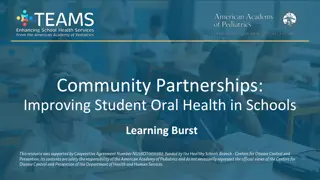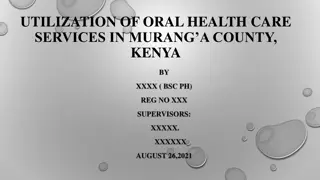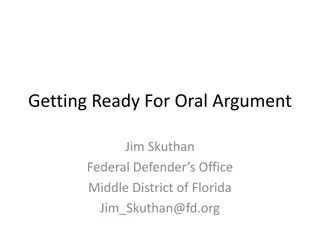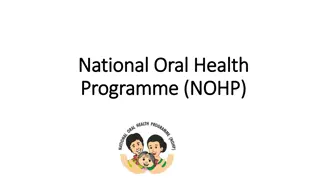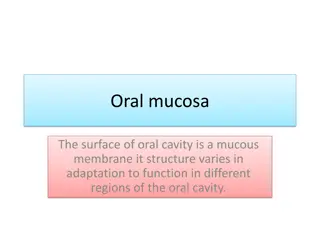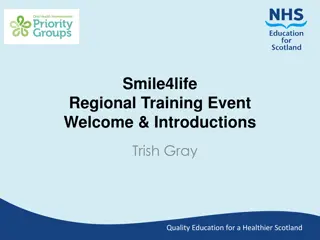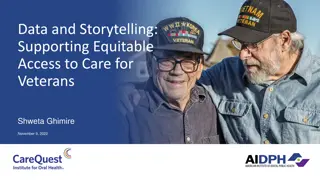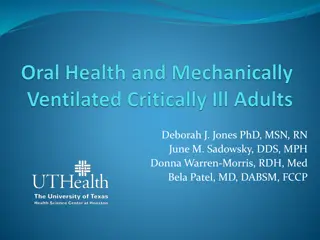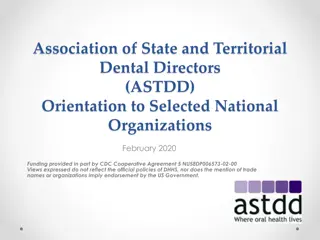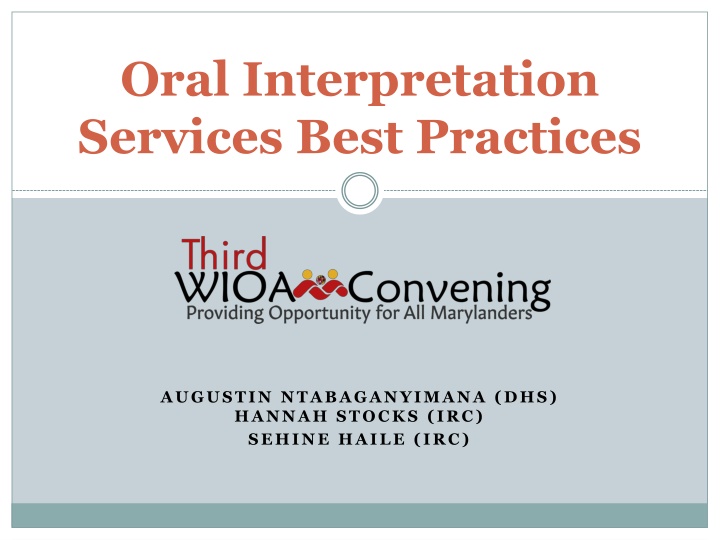
Oral Interpretation Services Best Practices in Maryland
Discover best practices for oral interpretation services in Maryland, including telephonic and in-person interpretation options provided by contracted vendors like Language Line Solutions and Ad Astra. Explore written translation services by vendors like Schreiber Translations, Inc., and learn about eligibility for services and contacts for Maryland state agencies.
Download Presentation

Please find below an Image/Link to download the presentation.
The content on the website is provided AS IS for your information and personal use only. It may not be sold, licensed, or shared on other websites without obtaining consent from the author. If you encounter any issues during the download, it is possible that the publisher has removed the file from their server.
You are allowed to download the files provided on this website for personal or commercial use, subject to the condition that they are used lawfully. All files are the property of their respective owners.
The content on the website is provided AS IS for your information and personal use only. It may not be sold, licensed, or shared on other websites without obtaining consent from the author.
E N D
Presentation Transcript
Oral Interpretation Services Best Practices AUGUSTIN NTABAGANYIMANA (DHS) HANNAH STOCKS (IRC) SEHINE HAILE (IRC)
Maryland Department of Budget and Management STATEWIDE FOREIGN LANGUAGE INTERPRETATION/ TRANSLATION SERVICES (FLITS)
Language Line Solutions is contracted with the State of Maryland for telephonic interpretation. Telephonic interpretation services allow staff to serve a customer through the assistance of an external, third party interpreter. Staff can relay their conversations and questions in English over the telephone and their speech is interpreted and spoken back to a client in their preferred language. TELEPHONIC INTERPRETATION VENDOR
Ad Astra is contracted with the State of Maryland to provide in- person interpretation services. In-person interpretation is a real-time, face-to- face oral interpretation service option that allows customers to receive information in their preferred language with incorporation of cultural and syntactical context. Service is delivered on site by a certified interpreter. IN-PERSON INTERPRETATION VENDOR
Schreiber Translations, Inc. (Schreiber) is contracted with the State of Maryland to provide written translation services. Translation services allow for documents and print material to be converted to a customer s language. TRANSLATION SERVICES VENDOR
Procured contracts to provide Maryland State agencies, local governments, counties, municipalities, nonprofit organizations, etc. with interpretation and translation services ELIGIBLITY FOR SERVICE AND CONTACT FLITS website: http://www.dbm.maryland.gov/proc- contracts/Pages/statewide- contracts/LanguageContractHome.aspx State staff should contact the Language Access Coordinator in their area with questions DHS: Augustin Ntabaganyimana DLLR (DWDAL): Lauren Gilwee DLLR (DUI): Leroy Cox and Wayne Cooper
Working Effectively with an Interpreter International Rescue Committee Maryland From Harm to Home | Rescue.org
Training Objectives 1. Define Title VI and when to provide interpretation 2. Learn to work effectively with an interpreter 3. Understand the role of an interpreter 4. Discuss strategies for correcting an untrained interpreter 8 From Harm to Home | Rescue.org
Interpreter vs. Translator Interpreting: Rendering a message orally (or in a signed language) from one language into another Translating: Rendering a written text from one language to another in writing **An interpreter is not necessarily a qualified translator** 9 From Harm to Home | Rescue.org
Fluency PSA https://www.youtube.com/watch?v=fRaMKl5C_fI 10 From Harm to Home | Rescue.org
Title VI & Language Access Laws No person in the United States shall, on ground of race, color, or national origin, be excluded from participation in, or be denied the benefits of, or be subjected to discrimination under any program or exercise receiving federal financial assistance." 11 From Harm to Home | Rescue.org
Executive Order 13166 Agencies must provide meaningful access to services. LEP clients should receive services consistent with the organizational standard without unduly burdening the fundamental mission of the agency. Signed in 2000. 12 From Harm to Home | Rescue.org
How to work with an interpreter CRASH COURSE! 13 From Harm to Home | Rescue.org
Where do you position the interpreter? Choice C Please vote! Phone Provider Client Choice A Choice B Interp Interpreter Provider Client Choice D Provider Phone Client 14 From Harm to Home | Rescue.org
Where do you position the interpreter? Choice C Phone Provider Client Choice B Choice A Interp Interpreter Provider Client Choice D Provider Client Provider Phone Client 15 From Harm to Home | Rescue.org
How to work with an interpreter and WHY? Look at and speak directly to the client not the interpreter! Use first person Ex: What are you taking for the pain NOT can you ask her what she is taking for the pain? Ask the client for clarification 16 From Harm to Home | Rescue.org
How to work with an interpreter and WHY? Speak slowly and pause every 2-3 sentences No side-conversations with the interpreter Check for understanding with the client EX: When and where will I see you again?, NOT Did you understand? Do not ask the interpreter about the client or the client s culture. Ask the client. 17 From Harm to Home | Rescue.org
Do not use children as interpreters! Video: http://www.youtube.com/watch?v=8fVR75ko0hM&list=PL4BB0BF3D6577B93C 18 From Harm to Home | Rescue.org
Correcting and guiding your interpreter 19 From Harm to Home | Rescue.org
Correcting and guiding your interpreter YOU manage the quality of your interpreted session Remind your trained interpreter of expectations and standards as necessary Set your untrained interpreter up for success 20 From Harm to Home | Rescue.org
Scenarios: 1. The interpreter appears to be interpreting long sentences or segments while you ask very short questions. What do you do? What do you say? 2. The client keeps turning to the interpreter and apparently asking questions. What do you do? What do you say? 3. The client and interpreter know each other well (or seem to know each other well). What do you do? What do you say? 4. The telephonic interpreter starts giving you advice on how to help the client. What do you do? What do you say? 21 From Harm to Home | Rescue.org
Summary Interpretation services allow your organization to serve all qualified beneficiaries. Good interpretation promotes self-sufficiency. The interpreter s job is to provide language services. They are not a cultural advisor or an expert on the client. The provider should focus on meeting and forming a working relationship with the client. It is the responsibility of the provider to set the interpreter and client up for success. 22 From Harm to Home | Rescue.org
Resources: NCIHC Ethics and Standards of Practice for Interpreters Quick Tips for Working with Interpreters Baltimore s Short (3 Hour) Interpreter Training This Presentation Key Terms for IRC Interpreters (Translated) More information on Title VI: http://www.justice.gov/crt/about/cor/Pubs/eolep.php DOJ Complaint Form: http://www.justice.gov/crt/about/cor/complaint.php 23 From Harm to Home | Rescue.org
Thank you. 24 From Harm to Home | Rescue.org
Breaking Down the Language Barrier US DOJ http://www.youtube.com/watch?v=qaVKy- 2HWIo&list=PL4BB0BF3D6577B93C Please watch from minute 18:30-19:30 OR from minute 0-1:18 OR 0-5:10 http://gofluently.com/fluency-psa.htm 25 From Harm to Home | Rescue.org
Legal Services of New Jersey Video Clip (Optional) https://www.youtube.com/watch?v=pVm27HLLiiQ (watch from :30) 26 From Harm to Home | Rescue.org

